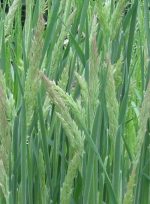 Common velvetgrass is a tufted perennial and a member of the grass family, Poaceae, that also includes bamboo, corn, and rice. It is native to Europe , western Asia, and northwest Africa but was introduced to the US in the 17th century and is now found in many states especially along the east and west coasts. Plants prefer moist conditions but adapt well to a variety of sites including roadsides, pastures, grasslands, meadows, cultivated fields, abandoned fields, lawns, ditch banks, and open forests and woodlands.
Common velvetgrass is a tufted perennial and a member of the grass family, Poaceae, that also includes bamboo, corn, and rice. It is native to Europe , western Asia, and northwest Africa but was introduced to the US in the 17th century and is now found in many states especially along the east and west coasts. Plants prefer moist conditions but adapt well to a variety of sites including roadsides, pastures, grasslands, meadows, cultivated fields, abandoned fields, lawns, ditch banks, and open forests and woodlands.
Description: Common velvetgrass has a fibrous root system that tends to be concentrated in the upper levels of the soil . The erect hollow stem is gray-green with pink stripes and grows up to thirty nine inches tall. Stems at the base of the plant may be somewhat prostate and form roots at their nodes. The pointed leaf blades are flat, two to eight inches long, and covered with dense, velvety hairs. The seed head is a grayish green plume-like panicle often tinged with purple, covered with hairs, and up to six inches long. The panicle consists of 2-flowered spikelets with short soft awns that become hooked when dry. Seeds are produced in abundance and can remain viable in the soil for up to twelve years.
Control: Digging or hand pulling the plants can be effective if care is taken to get all the roots. Hoeing, mowing or cutting plants to the ground every one to two weeks is effective but has to be repeated because new plants will sprout of root bases left behind. Removal of seed heads in important to prevent the spread of the weed. In sever cases selective herbicides such as fluazifop and sethoxydim are effective when applied to seedlings or larger plants as the seed heads emerge but several applications may be necessary.